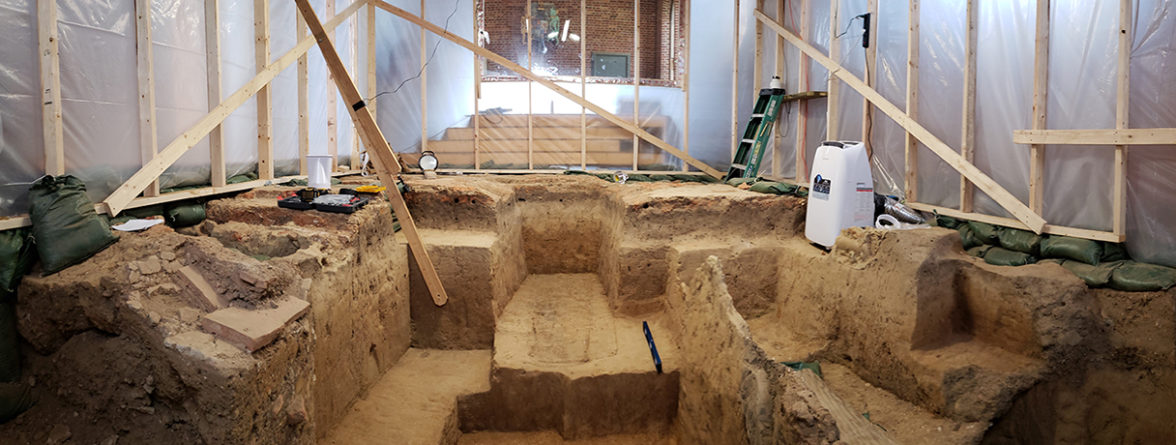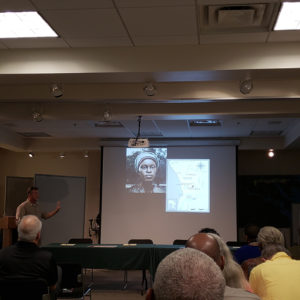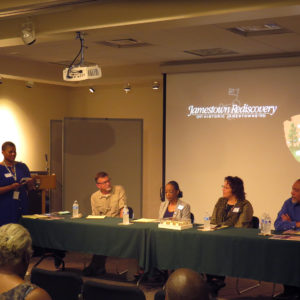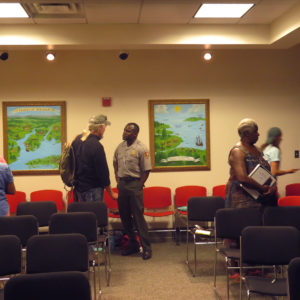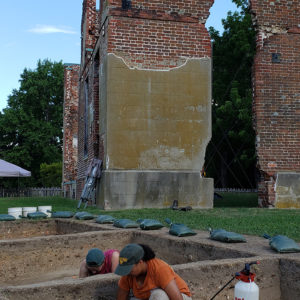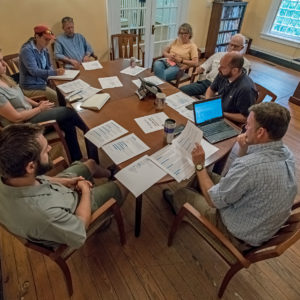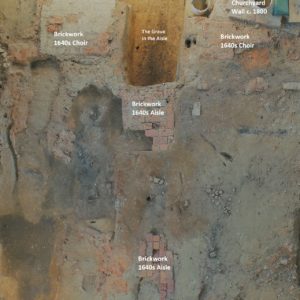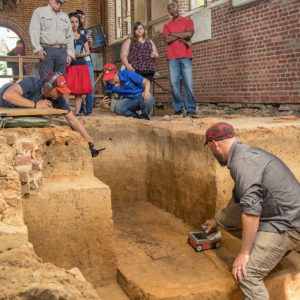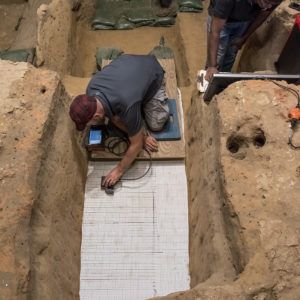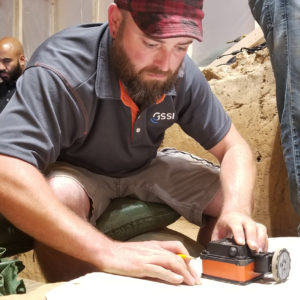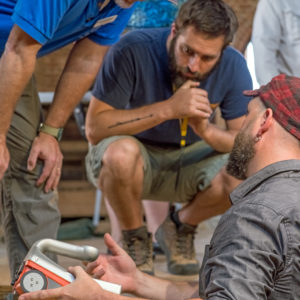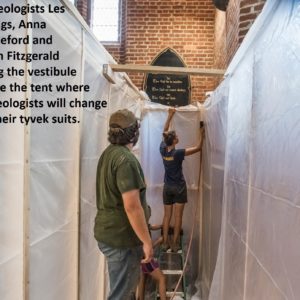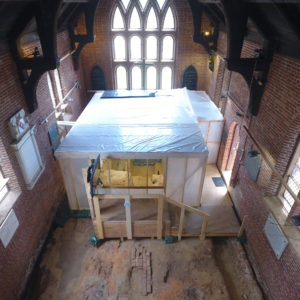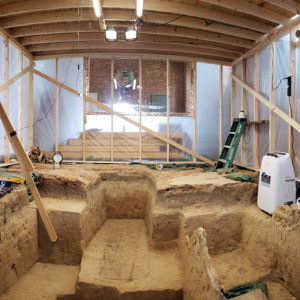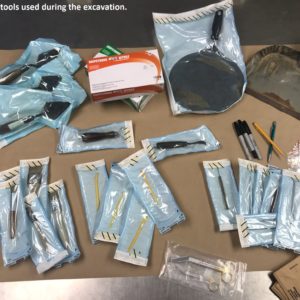Jamestown Rediscovery archaeologists are normally busy during the summer, but this July they kicked things into high gear! On July 6th, the Jamestown Rediscovery Foundation and the National Park Service – Colonial National Historical Park held the first descendant community meeting at the Historic Jamestowne Visitor Center. The purpose of the meeting was to introduce descendant community members to the research and archaeology completed thus far at the “Angela Site” in New Town, and to solicit recommendations and feedback on short-term and long-term interpretation efforts on Jamestown Island.
Angela and the other “twenty and odd Negroes” were the founding generation of African-American culture in English-speaking North America, but a sparse archival record tells us little about their lives and experiences in 17th-century Virginia. The archaeological examination of the site where Angela once lived allows us to illuminate the diverse stories that have been silenced in the documentary record, but they cannot be fully told without the support, involvement, and recommendations of the community. Consequently, this meeting is intended to be the first in a series in interpreting the history and culture of Africans and African-Americans at Jamestown.
About 20 community members attended the meeting and heard welcoming statements from Colonial National Historical Park Superintendent Kym Hall, Deputy Superintendent Steven Williams, and Preservation Virginia Chief Executive Officer Elizabeth Kostelny. Dave Givens, Director of Archaeology at Jamestown Rediscovery, presented an overview of the archaeological investigation and preliminary results. Following a short reception, a panel of experts presented comments on their own research on Colonial Africans. The panel was moderated by Eola Dance (Regional Cultural Anthropologist, NPS National Capital Region) and included Dr. Cassandra Newby-Alexander (Professor of History, Norfolk State University), Dr. Michael Blakey (National Endowment for the Humanities Professor, William & Mary), Liz Montgomery (Historian, First Baptist Church), and Dave Givens.
The overwhelming response to this first meeting was enthusiastic and positive. The audience expressed a clear desire for an authentic and accurate representation of African and African-American history and culture at Jamestown. Community members are particularly interested in the geopolitics of Angola and West Central Africa in the 17th century and how this region connected to the wider Atlantic world. Additionally, there was an interest in further exploring Angela’s story and times as a bridge to help fill in the gaps in African American history and to reach a global audience. The next descendant community meeting is planned for September.
Meanwhile, archaeologists in the Memorial Church focused on preparations for the excavation of a burial in the 1617 church’s central aisle that they theorized may contain the remains of Sir George Yeardley. Click here to learn more about “the Grave in the Aisle.”
Prior to the excavation of the grave, Rediscovery contacted specialists Peter Leach and Dan Welsh from Geophysical Survey Systems, Inc. (GSSI). Givens met Leach in 2017 when they worked with the NPS to conduct a ground penetrating radar (GPR) survey of a portion of the “Angela Site.” Leach mentioned that he would be interested in conducting other GPR tests on Jamestown Island.
“Peter was specifically interested in testing if high-frequency radar could identify human bone, something that had never been done,” said Givens. “Any time that we have the opportunity to push the envelope of science, we take it.”
The “Grave in the Aisle” provided Leach with a chance to test GSSI’s new Structure Scan Mini XT with palm XT extension, which is normally used for finding rebar and wiring in concrete. In preparation for the GPR test, the team excavated the top layers of the burial to the level of the coffin stains and nails. Leach’s tests involved slowly running the Mini XT’s palm extension over grave on a grid of five centimeter increments. Within just a few hours, Leach had his answer—the Mini XT was successful! Not only did the GPR image human bone, the resolution was high enough to show the skeleton’s orientation, indicating that the individual’s head was oriented in the east instead of the west.
Prior to the excavation, Rediscovery also enlisted the assistance of Dr. Turi King of the University of Leicester, England. King is the geneticist and archaeologist who helped identify the remains of King Richard III when he was discovered under a parking lot in 2012. Archaeologists felt that in order to more definitively identify the remains, they should conduct DNA analysis. On King’s recommendation, the team took every possible precaution in order to prevent modern DNA contamination of the archaeological samples necessary for the DNA sequencing.
Rediscovery autoclaved and sterilized all of their tools and wore Tyvek suits with masks and double gloves during the excavation. Givens and Field Supervisor Bob Chartrand designed and built a large containment structure, which was air-conditioned to create a tolerable environment for the Tyvek-suited team of archaeologists and forensic anthropologists. The structure also served to limit access to and secure the grave site during the excavation.
“The idea was that if we were to take a ‘belt and braces’ approach as Turi recommended, and every possible precaution was taken to prevent contamination, then there would be fewer questions about the results,” said Senior Staff Archaeologist Mary Anna Hartley.
For more exciting news about the “Grave in the Aisle,” please stay tuned for the August Dig Update!
related images
- Deputy Superintendent of Col. Nat. Park Steve Williams welcomes everyone to the first Descendant Community Meeting, which was held on July 6, 2018 at the Historic Jamestowne Visitor’s Center
- Jamestown Rediscovery Director of Archaeology Dave Givens presents information about the Angela Site and some of the discoveries made by the archaeologists
- The panel of experts at the first Descendant Community Meeting was moderated by Eloa Dance and included Dave Givens, Liz Montgomery, Dr. Cassandra Newby-Alexander, and Dr. Michael Blakey
- Some of those in attendance chatted following the meeting
- Chardé Reid and Angelina Tomasura trowel test units at the Angela Site
- The Jamestown Rediscovery team discusses plans for the excavation of the Grave in the Aisle
- Brick features around the Grave
- The grave in the aisle prior to the GPR testing
- Peter Leach from GSSI scans the grave in the aisle with a high-frequency GPR unit
- Team members from Jamestown Rediscovery and Geophysical Survey Systems, Inc working together to collect GPR data of the burial prior to excavation
- The GSSI team uses the Structure Mini xT GPR unit on the Grave in the Aisle
- Peter Leach using the mini GPR unit
- Dave Givens and Bob Chartrand examine the GPR data with Peter Leach from GSSI
- Archaeologists Les Jennings, Anna Shackleford, and Kaitlyn Fitzgerald sealing the vestibule outside the tent where archaeologists will change into their Tyvek suits
- Archaeologists installed a plexiglass window (donated by Waverly Glass Shop) so staff, colleagues, and media could observe the excavations
- The tent built for the excavations inside the Memorial Church
- The containment structure built in the church, over the site, to help with climate control and to limit access during the extraction of DNA samples
- Some of the tools used during the excavation


